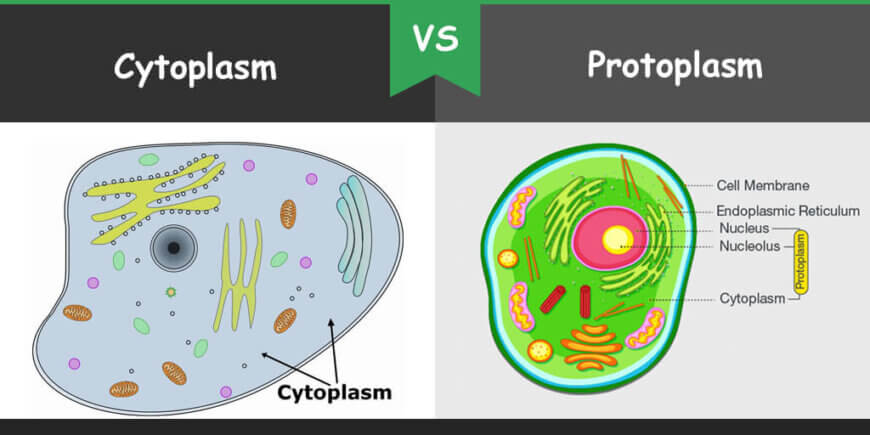The difference between Cytoplasm and Protoplasm is that A cytoplasm is defined as the protoplasm or all the material that exists within the cell except for the nucleus. On the other hand, a protoplasm is defined as the total colorless material that exists within the cell including the cytoplasm, nucleus, and other parts.

Contents
Comparison Chart
| Basis | Cytoplasm | Protoplasm |
| Definition | The protoplasm or all the material that exists within the cell except for the nucleus. | The total colorless material that exists within the cell including the cytoplasm, nucleus, and other parts. |
| Function | The cell substance between the cell membrane and the nucleus, which contains the cytosol, organelles, cytoskeleton, and various particles. | The entire living content of a cell surrounded by a cell membrane, which includes the nucleus and other parts. |
| Nucleus Location | Does not contain the nucleus. | Contains the nucleus. |
| Salt Presence | Proteins, water and other salts. | Proteins, water and other salts. |
What is Cytoplasm?
A cytoplasm is defined as the protoplasm or all the material that exists within the cell except for the nucleus. The submicroscopic ground cell substance or cytoplasmatic lattice which stays after rejection the cell organelles and particles is ground plasma. It is the hyaloplasm of light microscopy and high perplexing, polyphasic framework in which all resolvable cytoplasmic components of are suspended, including the bigger organelles such the ribosomes, mitochondria, the plant plastids, lipid beads, and vacuoles. The greater part of the critical exercises of the cell happens in the cytoplasm.
Cytoplasm contains particles, for example, chemicals which oversee separating waste and furthermore help in metabolic movement. Cytoplasm manages to give a cell its shape. It rounds out the cell and keeps organelles in their place. Without cytoplasm, the cell would be emptied, and materials would not have the capacity to pass effortlessly starting with one organelle then onto the next.
Cytoplasm is present within the cell membrane of all cell types and contains all organelles and cell parts. Cytosol is the piece of the cytoplasm that does not contain organelles. Rather, cytosol kept by the limits of a network which fills the portion of the cell that does not contain organelles. It is inside the cytoplasm that most cell exercises happen, for example, numerous metabolic pathways including glycolysis, and procedures, for example, cell division. The concentrated internal region is known as the endoplasm, and the outside layer is called the cell cortex or the ectoplasm.
What is Protoplasm?
A protoplasm is defined as the total colorless material that exists within the cell including the cytoplasm, nucleus, and other parts. Protoplasm is made from a blend of little particles, for example, particles, amino acids, monosaccharides and water, and macromolecules, for example, nucleic acids, proteins, lipids, and polysaccharides. In eukaryotes, the protoplasm encompassing the cell core gets known as the cytoplasm and that inside the heart as the nucleoplasm.
In prokaryotes, the material inside the plasma film is the bacterial cytoplasm, while in Gram-negative microbes the area outside the plasma layer however inside the external film is the periplasm. It incorporates all that is inside the cell divider, except for the core. It’s saltiness and mineral substance is near seawater, as living cells developed in the ocean. It gets thickly loaded with various particles and a wide range of atoms. It additionally houses bigger sub-cell organelles, for example, mitochondria. Cells must get rid of excretory wastes; they usually diffuse out of the cell through the cell membrane. It is, just, the inner ocean of life.
The substance responses such are reality itself work in an exceptionally limit scope of conditions. Saline liquid at a particular temperature of an exact pH and ionic adjust loaded with heaps of particles sufficiently close to Bob into each other so that all the compound responses of making proteins, fats, sugars, and that’s only the tip of the iceberg, and separating them, can happen.
Key Differences between Cytoplasm and Protoplasm
- A cytoplasm gets defined as the protoplasm or all the material that exists within the cell except for the nucleus. On the other hand, a protoplasm gets defined as the total colorless material that exists within the cell including the cytoplasm, nucleus, and other parts.
- Cytoplasm becomes known as the cell substance between the cell membrane and the nucleus, which contains the cytosol, organelles, cytoskeleton, and various particles. On the other hand, protoplasm becomes known as the entire living content of a cell surrounded by a cell membrane, which includes the nucleus and other parts.
- Both the parts have the same chemical substances that make them and exist within them and some of these include proteins, water and other salts.
- Protoplasm actually consists of the cytoplasm along with the nucleus. On the other hand, cytoplasm does not consist of a protoplasm.
- The concentrated internal region is known as the endoplasm, and the outside layer is called the cell cortex or the ectoplasm for both the entities.
- Protoplasm usually consists of all the living parts of the cell, on the other hand, cytoplasm mostly consists of non-living and living parts of the cell.